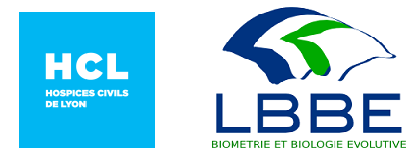LBBE/HCL

Created in 1802, the Hospices Civils de Lyon (HCL) are the 2nd university hospital in France. It involves 14 establishments in the region of Rhône-Alpes whose 3 of them are generals and propose several services as emergency, medicine, surgery in many disciplines, 7 are specialized institutions and 4 are geriatric establishments. The HCL are composed of 23 000 professionals with 5 000 medical professionals and 850 000 m² of patrimony. They also are part of the Institut d’Hémathologie et d’Oconlogie Pédiatrique (IHPOE) which is an institution specialized in the treatments of cancer in partnership with the Léon Bérard Center.
The HCL also involve a Biological Resource Center (CRB) called NeuroBioTec which was created in 1996. It purpose is to satisfy researchers and more particularly to store and supply qualified human biological material towards institutional or private users, which are fundamental criteria to insure successful researches. It is composed of 9 employees, more than 151 000 samples, 22 collections and since 2010, NeuroBioTec is certified according to the specific standard in Centers of Biological Resources, NF S-96 900.
The biostatistics department at the university-hospital is also part of the team of the Biostatistics/ Health group in the Laboratoire Biométrie et Biologie Evolutive (LBBE, UMR CNRS 5558), UCBL1. Working in collaboration with practitioners, projects lead to develop research in modelisation for epidemiology and clinical research and expertise in biostatistical methods dedicated to medical applications. Trials, including European trials, are routinely/regularly managed for statistical aspects. The Haut Conseil de l'évaluation de la recherche et de l'enseignement supérieur (HCERES) has evaluated the department as excellent regarding its project and outstanding regarding its research program.
The department analyses data from the French registries of cancer FRANCIM for cancer incidence and cancer survival description and prediction for public institutions such as l’Institut National du Cancer (INCa). It is used to work on huge databases, stemming for example from regional and national registries, or from studies related to high dimensional data (genomic, transcriptomic). Relating optimism bias, regression to the mean and selection process, the team has been involved in the estimation of models predictive performances. Since 10 years, penalized regression models have been studied, and developed regarding the curse of dimensionality.
One of the research axes of the Biostatistics/Health group is about individual prediction and personalized medicine. The unit has consequently an expertise in field of risk factor analysis and score building. Especially, is has worked on metrics to quantify the adequacy of the proposed model (R squared for survival data), and on methods to test and reduce the optimism of the model obtained. The biostatistics department works regularly on the analysis of prognostic factors, and has developed several scores, in various fields as in oncology. It is used to work on European projects (FP7, H2020: Wake-Up, Tension), and is involved in numerous collaborations at the national level with academics or institutions (Agence de Biomédecine, l’Institut de Recherche pour le Développement, Fédération Francophone de Cancérologie Digestive, Santé Publique France (anciennement InVS), l’INstitut National du Cancer (INCa)).
Every year, the team members author around 80 papers in peer-review journals (2 New England Journal of Medicine in 2018, 1 Lancet and 1 Journal of the National Cancer Institute on 2019).
TEAM LEADER:
Pr. Delphine Maucort-Boulch is a public health medical doctor by education and biostatistician by training. She is a full professor in the Biostatistics Health group from UMR CNRS 5558, Biometry and Evolutionary Biology laboratory (LBBE). She supervises the research axe “Individual prediction - Biomarker identification - BioInformatics » with Pr P. Roy. The group has a strong expertise in diagnostic and prognostic biomarkers identification. Overall, the team is involved in 43 national Clinical Research Projects, 31 regional ones, 5 projects granted by the ANR, 1 by the ANRS, and 1 on-going European trial in the H2020 context. Every year, the unit authors or co-authors more than 60 publications in international journals.
1. Obadia JF, Messika-Zeitoun D, Leurent G, Iung B, Bonnet G, Piriou N, Lefevre T, Piot C, Rouleau F, Carrie D, Nejjari M, Ohlmann P, Leclercq F, Saint Etienne C, Teiger E, Leroux L, Karam N, Michel N, Gilard M, Donal E, Trochu JN, Cormier B, Armoiry X, Boutitie F, Maucort-Boulch D, Barnel C, Samson G, Guerin P, Vahanian A, Mewton N. Percutaneous Repair or Medical Treatment for Secondary Mitral Regurgitation. N Engl J Med 2018;379(24):2297-2306.
2. Elsensohn MH, Leblay N, Dimassi S, Campan-Fournier A, Labalme A, Roucher-Boulez F, Sanlaville D, Lesca G, Bardel C, Roy P. Statistical method to compare massive parallel sequencing pipelines. BMC Bioinformatics. 2017 Mar 1;18(1):139.
3. Klich A, Mercier C, Gerfault L, Grangeat P, Beaulieu C, Degout-Charmette E, Fortin T, Mahé P, Giovannelli JF, Charrier JP, Giremus A, Maucort-Boulch D, Roy P. Variance component analysis to assess protein quantification in biomarker validation: application to selected reaction monitoring-mass spectrometry. BMC Bioinformatics. 2018 Mar 1;19(1):73
4. Rouvière O, Dagonneau T, Cros F, Bratan F, Roche L, Mège-Lechevallier F, Ruffion A, Crouzet S, Colombel M, Rabilloud M.Diagnostic value and relative weight of sequence-specific magnetic resonance features in characterizing clinically significant prostate cancers. PLoS One. 2017 Jun 9;12(6):e0178901.
5. Ozenne B, Subtil F, Maucort-Boulch D. The precision--recall curve overcame the optimism of the receiver operating characteristic curve in rare diseases. J Clin Epidemiol. 2015 Aug;68(8):855-9


